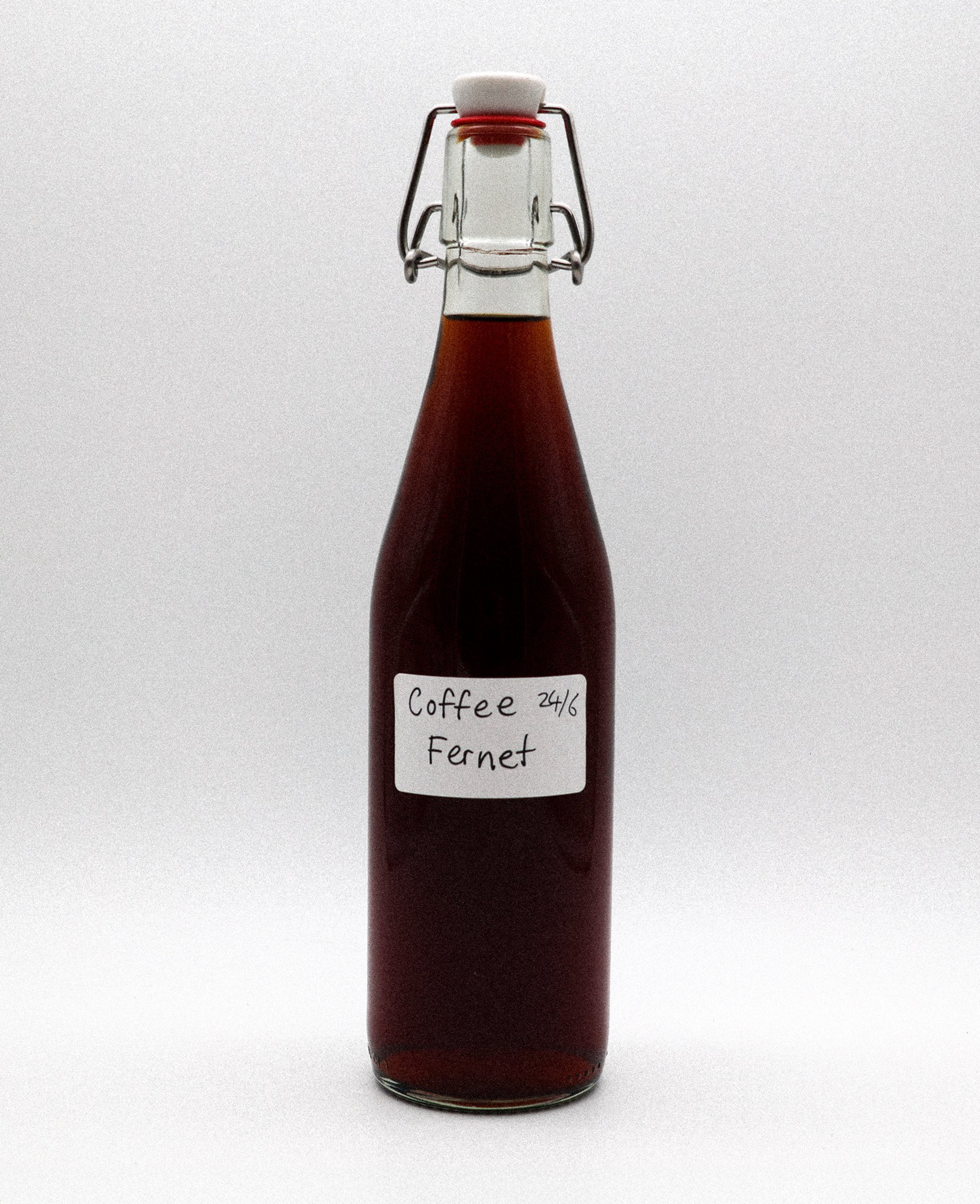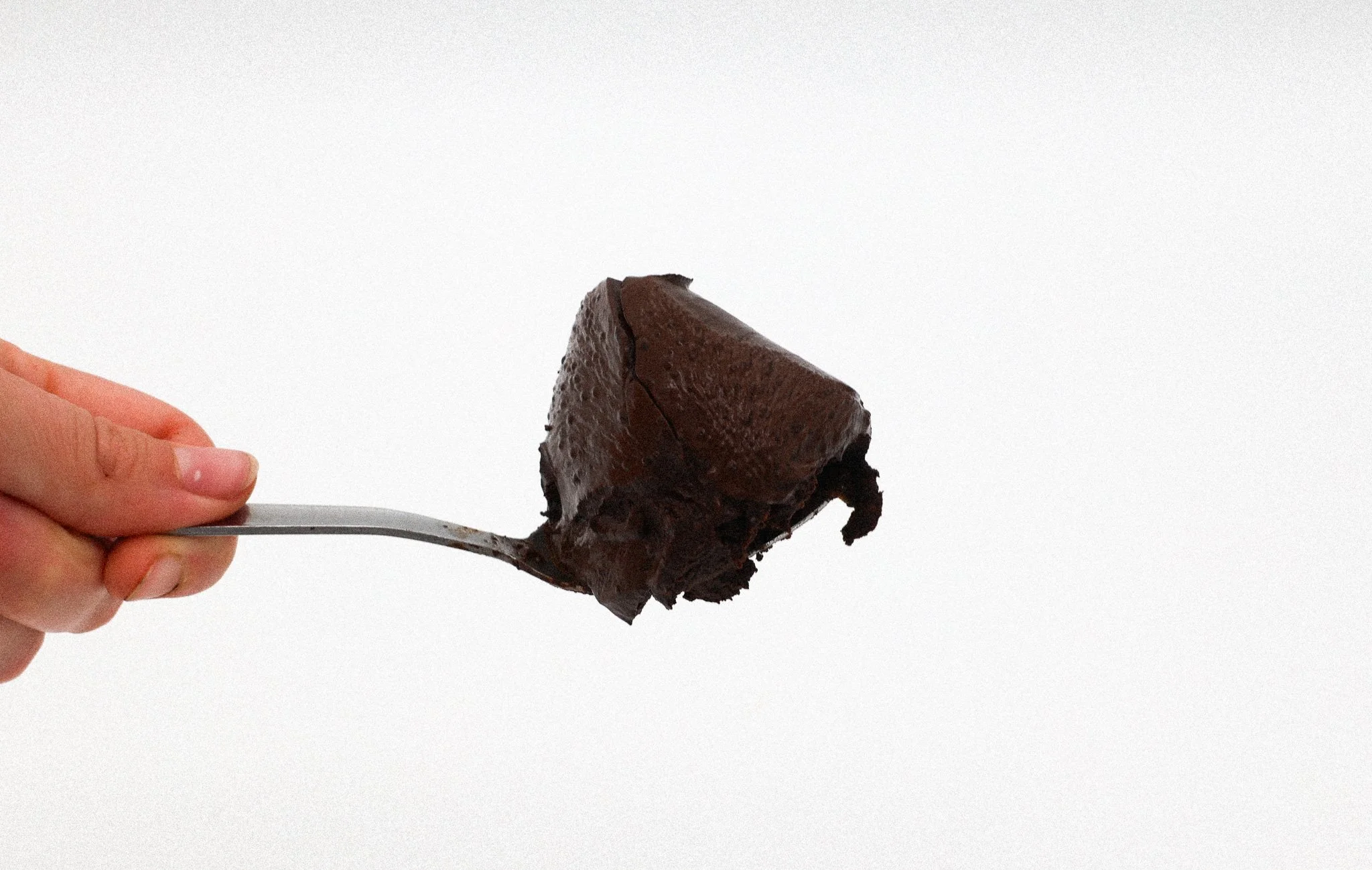Spent coffee fernet & fudge
This is part of our series on upcycling coffee by-products.
Table of Contents
i. Background
Fernet Branca is a bracing digestif made up of a mysterious list of 27 aromatic ingredients, with a complex bitter, medicinal and menthol flavour.¹ Legend has it that the original recipe is known by only one living person.² Though Fernet Branca is undoubtedly the most iconic, it belongs to a broader family of dark, bitter digestifs known collectively as ‘fernets’.³
Fernet Branca has something of a cult following among restaurant industry workers here in Copenhagen and elsewhere. So it’s no surprise that, when considering novel applications for spent coffee grounds, Kim’s brain went toward fernet territory. Coffee’s dark, complex flavours lends itself well as a backbone for a fernet.
Kim found a way to turn the spent coffee grounds into something equally as drinkable as Fernet Branca by treating them with enzymes and infusing them into neutral spirit. Centrifuging this concoction to separate out the digestif also leaves behind a thick, creamy (and quite alcoholic!) paste, almost like a ganache. This solid ‘by-by-product’ can be used as a fudge or as an ingredient in other desserts—a lovely bit of second-order upcycling!
We’re including two variations of this recipe here: the original coffee fernet with its fudge of similarly rich herbal complexity and a stripped-back version where the coffee is more the star of the show. Both are delicious; each might work better for different applications.
Fernet coffee fudge
ii. Recipe
a. Coffee fernet & fudge
This is the original recipe, that produces a complex fernet-style liqueur and a similarly flavoured fudge.
Ingredients
1000g neutral grain spirit (40% alcohol)
10g fresh rosemary needles
5g calendula petals, dried
10g rhubarb stalks, dried
5g rose petals, dried
4g dahlia flowers, dried
7g lilac flowers, dried
200g spent coffee grounds (dry weight)
4g cellulase, or 0.33% by mass of other ingredients
4g hemicellulase, or 0.33% by mass of other ingredients
Method
Grind the coffee, enzymes and spirit alcohol in an electric stone mill for 24 hours. If making the fudge, taste to ensure that the particles are <20µm.⁴
Combine with the remaining ingredients in a heat-proof vacuum bag, and fully seal.
Heat in a water bath at 60°C for 72 hours.
Denature the enzymes by heating the mixture in a water bath at 90°C for 15 minutes. Ensure the mixture is still sealed, since heating the mixture above 68°C will evaporate the alcohol.
Chill the mixture (to fridge temperature) and centrifuge for 20 minutes at 4800 rpm.
Reserve the centrifuged liquid and solids separately.
The liquid can be bottled and stored at room temperature (away from direct sunlight) or chilled, however you prefer to store your alcohol. It is ready for use as a coffee fernet.
The solid by-product can be scooped and/or formed into the desired shape to serve as a fudge.
b. Plain coffee liqueur & fudge
This is a stripped-back version of the recipe that showcases the coffee flavour in the liqueur and fudge without all the aromatics and botanicals. The fudge is a by-product of centrifuging the liquid as with the original recipe.
Method
Grind the coffee, enzymes and spirit alcohol in an electric stone mill for 24 hours. If making the fudge, taste to ensure that the particles are <20µm.⁵
Place in a heat-proof vacuum bag, and fully seal.
Heat in a water bath at 60°C for 72 hours.
Denature the enzymes by heating the mixture in a water bath at 90°C for 15 minutes. Ensure the mixture is still sealed, since heating the mixture above 68°C will evaporate the alcohol.
Chill the mixture (to fridge temperature) and centrifuge for 20 minutes at 4800 rpm
Reserve the centrifuged liquid and solids separately.
The liquid can be bottled and stored at room temperature (away from direct sunlight) or chilled, however you prefer to store your alcohol. It is ready for use as a coffee liqueur.
The solid by-product can be scooped and/or formed into the desired shape to serve as a fudge.
Ingredients
1000g neutral grain spirit (40% alcohol)
200g spent coffee grounds
4g cellulase, or 0.33% by mass of other ingredients
4g hemicellulase, or 0.33% by mass of other ingredients
iii. Adaptations
Drink this coffee fernet just as you would a traditional Fernet Branca, or as an ingredient in a cocktail—for example, why not try to adapt some of the recipes listed here?
You could also try experimenting with different flavour combinations to make your own fernet, following the same basic idea of enzymatically treating a mixture of alcohol, spent coffee grounds and whatever other flavourings you prefer, to produce a flavoured liqueur and a fudge.
Since cellulase and hemicellulase are industrial enzymes, they can be difficult to obtain in small, food-grade quantities. This may make it challenging to execute this recipe as is. However, instead of adding enzymes, you can add sugar (how much is to your preference) before centrifuging, as the enzymes' role is to break down the coffee grounds into sugars anyway. Additionally, if you don't have access to a stone mill or centrifuge, you can still make a similar recipe by steeping the mixture and then straining it through a coffee filter. It might not be as complex and rich in flavour, but it will still be good.
We also tried to make this recipe using water instead of alcohol to see if we could make a non-alcoholic fudge. Unfortunately, it didn’t work well: unlike the clarified fernet, the resulting liquid was cloudy, viscous and unpleasant tasting, and the solids didn’t emulsify. We wouldn’t recommend it.
Contributions & acknowledgements
Kim performed the original culinary R&D. Aly reproduced Kim’s recipe, conducted further R&D and documented the process with additional notes, which Eliot used to help write the article following further discussions with Kim. Josh contributed editorial feedback. Aly photographed the final product in our food lab.
This recipe has roots in Kim’s previous work as Head of R&D at the former Amass Restaurant in Copenhagen. Thank you Amass for facilitating such trailblazing work in culinary upcycling and holistic sustainability.
Related posts
Endnotes
[1] Fernet Branca official website.
[2] Clayton Hartley (2015) ‘Don’t be afraid of Fernet Branca’, Institute for Alcoholic Experimentation.
[3] Other examples include those here: Eater (2015) ‘Beyond Branca: Taste-Testing 10 Different Fernets’
[4] This is generally considered the point at which particles became imperceptibly small to most eaters, resulting in optimally smooth food. See e.g. Lina Engelen, René A. de Wijk, Andries van der Bilt, Jon F. Prinz, Anke M. Janssen, Frits Bosman (2005), ‘Relating particles and texture perception’, Physiology & Behavior.
[5] Ibid.




